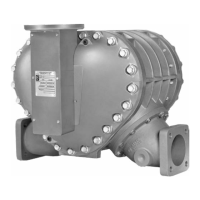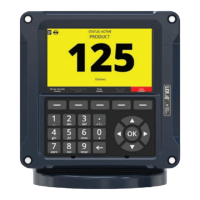OPERATION REQUIREMENTS
An easy way to accomplish this is to put the meter assembly in the
line below the piping center-line (a sumped position). This requires
adding elbows and anges prior to installing the meter. The meter
should be installed in a bypass loop, below the pipe center-line,
with block valves upstream and downstream of the meter inside
the bypass loop. A block valve should be located in the main
pipeline and labeled as the bypass valve.
Any portion of pipe system that might isolate or block ow should
be provided with a pressure relief to prevent damage from thermal
expansion. There are excellent benets to this type of installation.
First, the meter is kept full. Second, this type of installation
allows the meter to be isolated for servicing and calibration while
continuing ow through the bypass valve.
Upstream lines must be maintained full to prevent air from entering
the meter. If upstream or inlet lines are constructed in a manner
which allows reverse ow, foot valves, or back checks must be
installed.
Underground tanks that are furnished with a submersible pump
will eliminate many problems that occur with positive displacement
pumps (suction pumps) when suction piping is incorrectly sized or
when the lift is too great.
STANDARDS
Every meter should be calibrated under actual service and
installation conditions per the API Manual of Petroleum
Measurement Standards:
The following chapters of the API Manual of Petroleum Measurement
Standards supersedes the API standard 1101.
Chapter 4 - Proving Systems
Chapter 5 - Metering
Chapter 6 - Metering Assemblies
Chapter 11 Section 2.3 - Water Calibration of
Volumetric Provers
Chapter 12 Section 2 - Calculation of Petroleum
Quantities
DIVERTING LIQUID FOR CALIBRATION
PURPOSES
1. The meter is properly secured
2. All connections are tight
3. All valves are in the closed position
PLACING YOUR METER IN OPERATION
When placing your meter in operation, the meter and system must be
lled slowly with liquid and be free of air prior to start-up. Extreme care
must be taken to avoid damaging the meter during this time. When lling
the system with liquid for the rst time, gravity lling is the preferred
method of lling the system with liquid. Gravity lling uses positive head
pressure from product storage above the inlet port of the meter to ll the system. If necessary, systems can be lled
with the pump.
1. Make sure all valves (upstream and downstream of the meter) in the system
are closed.
2. Open the valve located at the storage tank a small amount. Provided there is
not a valve between the tank and the meter inlet, the meter’s register/counter
will start to move and then stop. If there is another valve between the tank and meter, repeat this process with each valve until
the meter is exposed to the liquid.
3. Once you are assured that the meter has registered some volume and stopped, continue to open the tank valve until it is
completely open.
4. With the valve(s) open between the tank and the meter, slowly open the downstream valve until the meter’s register/counter
starts to move. Do not run the meter any faster than 25% of its rated ow during start-up. Once the product is owing out of the
end of your system, the outlet valve can be opened all the way, provided that the system is designed not to exceed the ow
rate marked on the meter.
METER START UP AND OPERATION
Make sure that your pump can operate
against a dead head pressure. If not,
consult the factory for assistance.
Dead Head Pressure - Pumps
Prime the pump before using it to ll the
system. Consult the pump manufacturer
for proper pump priming.
Prime the Pump First
Before disassembly of any meter or accessory component:
For Safety Rules, refer to local authorities and relevant NFPA Codes.
! WARNING
If the valves are not manual, consult the
valve manufacturer for slow ow start-up.
Give careful attention to your system’s pumping equipment and
piping. Because of their inuence on liquid being measured as it
enters the metering assembly, systems should be made free of
conditions that cause or introduce entrained air or vapor.
RECOMMENDATION FULLY WHEN INSTALLING
PUMPS
Give particular attention to factors like: use of foot valves, pipe
size to the inlet, and conformance to net positive suction head
(NPSH) conditions when suction pumping is required. Follow
the manufacturer’s recommendations to minimize air and vapor
elimination problems.
For liquids such as light hydrocarbons that tend to ash or
vaporize easily at higher ambient temperatures, it is advantageous
to use ooded suctions and piping sized larger than the nominal
pump size.
On vehicle tank installations, the layout of the system’s piping
is crucial in preventing problems with split compartment
test conformance. Piping should slope away from a positive
displacement pump to prevent resurgent re-priming of the pump
due to drain back.
Hydraulic shock is harmful to all the components of an operating
system, including the valves, the meter, and the pump. Because
of the high precision with which they measure products, meters,
in particular, must be protected against hydraulic shock. The best
protection against hydraulic shock is to prevent it from occurring.
To prevent hydraulic shock, adjust the closing rate of the valve
until shock does not occur.
Thermal expansion, like hydraulic shock, can easily damage
meters and other components in the system. When designing the
system, include pressure relief valves in any portion or branch of
the system that might be closed off when an operating or block
valve is closed.
WITH POCKETS OF COMPRESSED AIR OR
If these conditions cannot be avoided, air and vapor elimination
systems may be required. If you cannot ll the meter slowly by
gravity or by using a valve to throttle back the ow, consult the
factory.
Under any and all pressure producing circumstances (for instance,
thermal expansion and hydraulic shock) the working pressure
must not exceed the maximum pressure indicated on the Serial
Number Plate.
NUMBER PLATE
If the meter is operated at a rate greater than the maximum
recommended GPM, excessive wear and premature failure may
occur.
BELOW MINIMUM RATINGS
If the ow remains constant and varies within narrow limits or if
the product is viscous, the meter can be calibrated for ows below
minimum ratings. If the meter is installed in a custody transfer
application (for nancial transactions), the ow rate must fall within
ow rate range indicated on the serial number plate. A meter
should never be run beyond the maximum ow rate determined for
that class meter and/or liquid measured.
9
8

